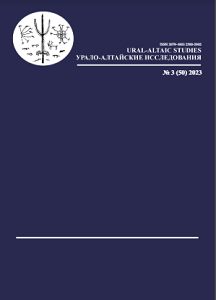Глагол некэ- в тунгусо-маньчжурских языках: функции и развитие значений
The Tungusic verb ɲeke-: its functions and the evolution of its semantics
Author(s): Elena L. KlyachkoSubject(s): Language studies, Phonetics / Phonology, Semantics, Sociolinguistics
Published by: Институт языкознания Российской академии наук
Keywords: Tungusic languages; quotative verb; discourse; hesitation; polipredication; ideophones;
Summary/Abstract: The paper considers ɲeke-, a highly polysemic verb present in several Tungusic languages: Evenki, Even, Negidal, Oroch, and Udihe. The meanings of the verb include ‘do’, ‘say’, ‘want’, ‘go’ and ‘hunt’. It also can be a euphemism for ‘have sex’. Moreover, ɲekecan also be used as an auxiliary verb or as part of a discourse connective when combined with an adverb meaning ‘so’, and it can be found in cases of verbal anaphora. The aim of the paper is to explain how this polysemy developed. The functions of the verb have previously been described only briefly in grammars and dictionaries. However, oral corpora and elicitation experiments allowed me to discover additional meanings not previously mentioned for some of the languages. These intralingual comparisons as well as typological data made it possible for me to suggest the following development. The original meaning of the verb was ‘do’, marking abstract actions. It then evolved to mean ‘want X’, introducing another verb as X. At the same time, the verb was used to introduce ideophones. This ideophone-introducing function helped develop it into a quotative verb in some of the languages. Finally, the abstract ‘do’ started to mean ‘move’ and then ‘hunt’. Its abstract ‘do’-meaning is what allowed it to be used as an auxiliary and as a part of a connective. In some Evenki dialects, ɲeke- was replaced with ke-, a Mongolic borrowing, which still retained the functions of ɲeke-. Interestingly, the verb seems to be present in the Tungusic languages mentioned above, while other Tungusic languages, such as Ulch or Nanay, have a similarly functioning verb with a different stem. This may support A. M. Pevnov’s hypothesis of ɲeke- being borrowed into a branch of the Tungusic languages from a Koryak placeholder stem.
Journal: Урало-алтайские исследования
- Issue Year: 2023
- Issue No: 03 (50)
- Page Range: 23-41
- Page Count: 19
- Language: Russian

